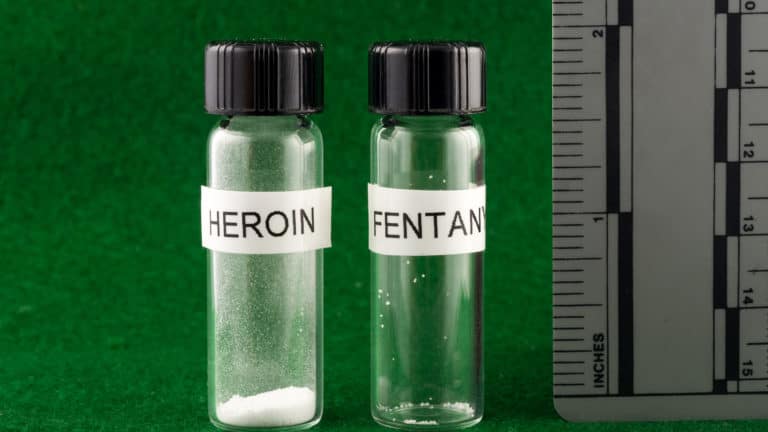Every day, 41 people die from an opioid overdose. The dangers of opioid addiction have nearly doubled in the last ten years. Read our opioid comparison of the 13 most common opioids and their individual characteristics.
Opioid Overdose and Death Rates
In 2016, 62 people per 100,000 visited the emergency room because of an opioid overdose. In the same year, the hospitalization rate for non-fatal opioid overdoses was 27 people per 100,000. Sadly, the overdose death rate that year was 13 people per 100,000. Death rates more than doubled in a 10-year period from 2006 to 2016.
The dangers of opioid use are evident in the above statistics provided by the Centers for Disease Control and Prevention (CDC). More importantly, it is critical to understand the distinctions between the various types of opioids and their strengths and severity.
Opioid Comparison
Even those prescribed opioids for pain relief are at risk of misuse, but some of the most commonly misused opioids are illicitly manufactured synthetic opioids. The opioids we feature in this guide are ordered from the lowest strength to the highest strength:
- Codeine
- Demerol
- Tramadol
- Morphine
- Vicodin
- Percocet
- Methadone
- Heroin
- Hydromorphone
- Oxymorphone
- Suboxone
- Fentanyl
- Carfentanil
Are you dependent on or addicted to one or more of the 13 most common opioids? Begin your opioid addiction recovery today by calling Asheville Recovery Center at (828) 518-6996.
Opioid Comparison Charts
In this ultimate opioid comparison guide, we examine more closely each of the opioids and compare the following characteristics:
- Commercial, generic, and street names
- Forms
- Methods of use
- Strength as compared to morphine
- Fatal dosages
- Short-term side effects
- Long-term side effects
- Overdose symptoms
- Withdrawal symptoms
- Withdrawal timelines
Commercial, Generic, and Street Names of Opioids
Do you know the language surrounding opioids and what they look like?
With the exception of heroin, the majority of opioids begin in a pill form because they are manufactured by pharmaceutical companies and prescribed by physicians. Widely available opioids such as morphine are manufactured by many different companies, so the pills come in different shapes, colors, and doses.
To get specific information based on a pill you possess, use WebMD’s pill identifier.
| Commercial Name | Generic Name | Street Names |
|---|---|---|
| Fioricet | Codeine | Captain Cody, Coties, Schoolboy With soft drinks/candy: Lean, Sizzurp, Purple Drank With hypnotic sedatives: Doors & Fours, Loads, Pancakes and Syrup |
| Demerol | Meperidine | Demmies, Pain Killer |
| Ultram | Tramadol | Chill Pills, Trammies, Ultras |
| Duramorph | Morphine | Dreamer, First Line, Joy Juice, Morpho, Miss Emma, Monkey, White Stuff, Mister Blue, Unkie |
| Vicodin | Hydrocodone | Vikes, Veeks, Idiot Pills, Scratch, 357s, Lemonade, Bananas, Dones, Droco, Lorries With valium and vodka: Triple V |
| Percocet | Oxycodone | 30s, 40s, 512s, Oxy, Beans, Blues, Buttons, Cotton, Kickers, Killers, Percs, Roxy |
| Dolophine | Methadone | Amidone, Biscuits, Fizzies , Jungle Juice, Maria, Wafer With MDMA: Chocolate Chip Cookies |
| Heroin | N/A | Brown sugar, China White, Dope, H, Horse, Junk, Skag, Skunk, Smack, White Horse With OTC cold medicine and antihistamine: Cheese |
| Dilaudid | Hydromorphone | D, Dillies, K4, Needle Candy |
| Opana | Oxymorphone | Biscuits, Blue Heaven, Blues, Mrs. O, O Bomb, Octagons, Stop Signs |
| Suboxone | Buprenorphine | Big Whites, Buse, Oranges, Small Whites, Sobos, Stops, Strips, Sub, Subs |
| Duragesic | Fentanyl | Apache, Blonde, Blue Diamond, Blue Diamond, China Buffet, China White, Snowflake, Humid, Jackpot, Murder 8, Tango and Cash, TNT, White Ladies, With heroin: Birria |
| Wildnil | Carfentanil | Drop dead, Serial killer, Gray death, TNT |
However, once the opioid becomes a powder, it is very difficult to know what you are getting into. In fact, oftentimes, dealers will disguise or combine multiple opioids to increase earning potential. Unfortunately, this also increases the potential for overdose.
Opioid Comparison of Forms and Strengths
We continue to order the 13 most common opioids from weakest to strongest. Many opioids are derivatives of morphine; therefore, the strength of each one is compared to the strength of morphine itself. Also included is the potentially fatal dose of each opioid.
| Drug | Forms and Methods | Strength (compared to Morphine) | Potentially Fatal Dose (approx) |
|---|---|---|---|
| Codeine | Tablet, capsule, liquid Injected, swallowed (often mixed with soda and flavorings) | mildest | 500 milligrams |
| Demerol | Tablet, liquid Swallowed, snorted, injected | 7 to 10 times less | 600 milligrams |
| Tramadol | Tablet, capsule, liquid Swallowed, oral drops, injectioned | one tenth | 300 milligrams |
| Morphine | Tablet, liquid, capsule, suppository Injected, swallowed, smoked | N/A | 200 milligrams |
| Vicodin | Capsule, liquid, tablet Swallowed, snorted, injected | similar | 325 milligrams |
| Percocet | Capsule, liquid, tablet Swallowed, snorted, injected | 2 times more | 325 milligrams |
| Methadone | Tablet, dispersible tablet, liquid Swallowed, injected | 3 times more | 30 milligrams |
| Heroin | White or brownish powder, or black sticky substance known as “black tar heroin” Injected, smoked, snorted | 2 to 5 times more | 30 milligrams |
| Hydromorphone | Liquid, suppository Injected, rectal | 2 to 8 times more | 25 milligrams |
| Oxymorphone | Tablet Swallowed, snorted, injected | 3 to 10 times more | 40 milligrams |
| Suboxone | Tablet, oral film (tongue, cheek) | 25 to 100 times more | 12 milligrams |
| Fentanyl | Lozenge, sublingual tablet, film, buccal tablet Injected, smoked, snorted | 50 to 100 times more | 3 milligrams |
| Carfentanil | Liquid, powder Injected, smoked, snorted | 10,000 times more | 2 milligrams (10 mg is used to sedate elephants) |
Keep in mind that any powder form you obtain could be a combination of several opioids, so it is difficult to know the strength and danger unless you know the exact composition.

Fentanyl is often sold as “more potent” heroin, but fentanyl is nearly ten times stronger than heroin and only 3 milligrams is a potentially fatal dose.
Opioid Comparison of Short-Term and Long-Term Side Effects
In the table below, you will see similar side effects across all opioids provided by the National Institute on Drug Abuse (NIDA). Depending on the individual, some short-term side effects may be more severe. The long-term effects, however, lead to horrific outcomes.
| Drug | Short-term Side Effects | Long-Term Side Effects |
|---|---|---|
| Codeine | Nausea and vomiting; Excessive drowsiness, dysphoria or confusion; Dry mouth; Constipation; Allergic skin reaction or rash. | Insomnia; Nightmares; Pain when not using the drug; Liver damage secondary to acetaminophen toxicity; Seizures. |
| Demerol | Drowsiness; Confusion; Nausea; Constipation; Low blood pressure; Low body temperature; Pinpoint pupils; Slurred speech; Slowed movement; Slowed pulse rate; Slowed breathing. | Hypoxia (inadequate oxygenation of blood and tissues); Brain damage; Psychological problems such as anxiety and depression. |
| Tramadol | Nausea; Vomiting; Constipation; Lightheadedness or dizziness; Drowsiness; Headache; Loss of appetite; Dry mouth. | Anxiety; Insomnia; Seizures. |
| Morphine | Nausea; Vomiting; Itchy skin; Appetite loss; Constricted, or pinpoint pupils; Urinary retention; Constipation; Shallow or slowed breathing; Altered or irregular heart rate and rhythm; Chest pain; Cyanosis (blue tint to skin, lips, fingernails, etc); Dizziness; Confusion; Agitation; Seizures. | Chronic constipation; Poor appetite; Reflux; Bloating; Stomach pain; Dry mouth; Weight loss. |
| Vicodin | Nausea; Constipation; Slowed breathing; Dizziness or lightheadedness; Impaired judgment; Confusion; Profound drowsiness; Loss of consciousness. | Hearing Loss; Chronic Constipation; Liver Damage; Kidney Failure; Cardiovascular Damage; Brain Damage; Reproductive Problems. |
| Percocet | Mood changes; Drowsiness; Headache; Dizziness; Dry mouth; Flushing; Sweating; Itching; Stomach pain; Nausea; Vomiting; Constipation; Loss of appetite; Weakness. | Liver damage; Kidney failure; Severe constipation; Urinary retention; Slightly decreased testosterone levels in men. |
| Methadone | Pinpoint pupils; Respiratory depression; Nausea; Lethargy; Mood swings. | Impaired Judgement; Heart problems. |
| Heroin | Dry mouth; Itching; Nausea; Vomiting; Analgesia; Slowed breathing and heart rate. | Collapsed veins; abscesses (swollen tissue with pus); infection of the lining and valves in the heart; constipation and stomach cramps; liver or kidney disease. |
| Hydromorphone | Headache; Pinpoint pupils; Stomach cramps; Constipation; Nausea; Vomiting; Muscle aches and pains; Dry mouth; Appetite loss; Dizziness/lightheadedness; Drowsiness; Anxiety; Itchiness; Rash; Hoarse voice; Loss of consciousness; Blood pressure changes; Slowed breathing; Seizures. | Infections and diseases from needle sharing (HIV, hepatitis, etc.); Track marks on arms and/or legs; Frequent mood swings; Anxiety; Depression. |
| Oxymorphone | Light-headedness; Sleepiness; Slowed respiratory rate; Headache; Dizziness; Fainting; Abdominal pain; Nausea; Vomiting; Constipation. | Chronic constipation; Weight loss due to stomach upset and appetite changes; Low heartbeat and low blood pressure; Brain damage due to lack of oxygen in the bloodstream from respiratory depression; Thyroid changes, which can change mood and weight; Muscle weakness or atrophy; Memory loss. |
| Suboxone | Constipation; Nausea and vomiting; Muscle aches; Insomnia; Irritability; Fever. | Confusion; Dizziness; Pupil constriction; Hallucinations; Low blood pressure; Respiratory depression; Seizure; Coma. |
| Fentanyl | Nausea; Vomiting; Constipation; Altered heart rate; Slowed breathing rate; Confusion; Hallucinations; Weakness; Sweating; Itchy skin; Constricted pupils; Seizures. | Increase your risk for anoxic injury (damage due to significantly decreased oxygen in the body tissues) and multiple organ system damage; Initiate, or worsen, mental health conditions. |
| Carfentanil | Nausea; Drowsiness; Restlessness; Sweating; Runny nose; Insomnia; Difficulty concentrating; Depression; Muscle aches; Anxiety; Disorientation; Pinpoint pupils; Clammy skin; Sedation; Death. | So dangerous, long-term effects have not been documented. Most users overdose and die if they make it through their first use. |
Consequently, it doesn’t matter the length of time of use or the time since the last use, anyone who uses any type of opioid is at risk for long-term health complications, especially breathing problems.
The side effects of opioid use and withdrawal symptoms can be very unpleasant. Dial (828) 518-6996 to speak with an Asheville Recovery Center representative to learn more about how we can help.
Opioid Comparison of Overdose and Withdrawal Symptoms
Similar to short-term side effects, an overdose on the various opioids present similar symptoms. Withdrawal symptoms are often worse than side effects. The peak of withdrawal of the majority of opioids will be 72 hours after the last use. However, the withdrawal timeline based on the type of opioid can vary widely.
| Drug | Overdose Symptoms | Withdrawal Symptoms | Withdrawal Timeline |
|---|---|---|---|
| Codeine | Cyanosis, or blue lips or skin; Loss of consciousness; Pinpoint pupils; Lack of a pulse; Shallow or halted breathing; Sluggish pulse or slowed heartbeat; Chest pain; Frequent vomiting; Extreme fatigue. | Irritability; Anxiety and depression; Difficulty sleeping; Muscle aches; Sweating; Stomach cramps; Diarrhea; Nausea and vomiting. | 2 weeks |
| Demerol | Cold and clammy skin; Bluish tinge to lips, tongue and nail beds; Loss of muscle strength; Bradycardia (slow heart rate); Respiratory depression; Extreme fatigue, Blurry vision; Vertigo or dizziness; Syncope or fainting; Coma. | Restlessness; Involuntary leg movements; Cold flashes; Insomnia; Anxiety; Agitation; Runny nose; Sweating; Dilated pupils; Dilated pupils; Gastrointestinal distress (nausea, vomiting, diarrhea). | 3 to 10 days |
| Tramadol | Decreased size of the pupils of the eyes (miosis); Slow breathing or difficulty breathing; Extreme drowsiness. Cold, clammy skin; Slow or irregular heartbeat; Seizure; Loss of consciousness; Coma. | Gastrointestinal pain; Depression; Diarrhea; Agitation; Numbness in the extremities; Ringing in the ears; Hallucinations; Paranoia; Agitation; Confusion. | 2 weeks |
| Morphine | A cold or clammy feel to the skin; Bluish hue in the fingertips and lips; Constricted (small) pupils; Blurry vision; Nausea; Vomiting; Severe constipation; Severely slowed or irregular breathing; Slow heartbeat; Limp muscles; Severe sleepiness; Loss of consciousness; Coma. | Extreme drug cravings; Anxiety; Irritability; Sweating; Runny nose; Diarrhea; Decreased appetite; Cramping; Vomiting; Chills. | 5 to 7 days |
| Vicodin | Nausea/vomiting; Constricted/pinpoint pupils; Hypotension (low blood pressure); Fatigue; Weak pulse; Slowed/shallow/difficult breathing; Respiratory arrest; Cyanosis (blue tint to lips and fingernails); Coma; Seizures. | Pain in the muscles and bone; Difficulty sleeping; Restlessness and uncontrollable leg movements; Nausea and vomiting; Diarrhea; Feeling cold. | 7 to 10 days |
| Percocet | Abnormally constricted or dilated pupils; Limp or weak muscles; Difficulty breathing; Slowed or stopped breathing; Slow or stopped heartbeat; Cyanosis (blue color of skin, fingernails, lips, or mouth area); Cold, clammy skin; Extreme drowsiness; Dizziness; Fainting; Loss of consciousness or coma. | Irritability, anxiety, and depression; Difficulty falling asleep or staying asleep; Restlessness; Muscle or joint aches and pains; Muscle weakness; Stomach cramps; Nausea/vomiting; Loss of appetite; Diarrhea; Increased heart and breathing rate; Flu-like symptoms (sneezing, runny nose, watering eyes, sweating, chills). | 4 to 7 days |
| Methadone | Dizziness; Drowsiness; Weak pulse; Low blood pressure; Muscle twitches; Confusion; Nausea and vomiting; Slowed heartbeat; Weak muscles; Clammy skin; Gray or bluish tint to the skin. | Agitation and irritability; Anxiety; Aches and increased pain; Watery eyes and runny nose; Trouble sleeping; Sweating; Frequent yawning; Stomach cramps; Goose bumps; Diarrhea; Nausea; Vomiting. | Up to 21 days |
| Heroin | Bluish nails or lips; Depressed breathing; Weak pulse; Pinpoint pupils; Disorientation or delirium; Extreme drowsiness; Repeated episodes of loss of consciousness; Coma. | Restlessness; Muscle and bone pain; Insomnia; Diarrhea; Vomiting; Cold flashes with goose bumps (“cold turkey”). | 1 week |
| Hydromorphone | Cold, clammy skin; Blue tint to lips, tongue, fingernails, toenails, etc; Decreased muscle strength; Markedly constricted or pinpoint pupils; Dilated, non-reactive pupils indicating brain injury from lack of oxygen; Bradycardia (slowed heart rate); Hypotension (low blood pressure); Fatigue; Dizziness; Fainting; Stupor; Respiratory depression; Respiratory collapse; Coma. | Loss of appetite; Runny nose; Teary eyes; Yawning; Restlessness; Fast breathing; Increased heart rate; Sweating; Chills; Stomach pain; Diarrhea; Nausea; Vomiting; Muscle or joint pain; Insomnia. | 1 to 2 weeks |
| Oxymorphone | Respiratory depression or arrest; Cold and clammy skin; Pupil constriction or dilation; Cyanosis (bluish tint to fingernails, skin, and lips); Muscle weakness; Extreme drowsiness; Loss of consciousness. | Anxiety; Restlessness; Insomnia; Fast heartbeat; Watery eyes; Sweating; Chills; Diarrhea; Nausea; Vomiting. | 5 to 7 days |
| Suboxone | Profound drowsiness; Intermittent loss of consciousness; Lack of coordination; Slurred speech; Vision problems; Slowed breathing; Sluggish reflexes. | Irritability; Anxiety; Body aches and cramping; Insomnia. Sweating; Dilated pupils; Nausea; Diarrhea; Vomiting; Intense opioid cravings. | 1 week to 1 month |
| Fentanyl | Difficulty swallowing; Extreme fatigue; Dizziness and fainting; Shallow, difficult breathing / respiratory arrest; Cardiac arrest; Non-responsiveness to painful stimuli; Severe confusion; Obtundation (altered level of consciousness). | Loss of appetite; Tremors; Agitation; Anxiety/panic; Fever and chills; Sweating; Nausea / vomiting; Runny nose; Diarrhea; Intense drug cravings. | 5 to 7 days |
| Carfentanil | Most often, death; Respiratory depression or arrest; Drowsiness, Disorientation; Sedation; Pinpoint pupils; Clammy skin. | Insomnia; Irritability; Low energy; Anxiety; Fever; Sweating; Teary eyes; Muscle aches and pain; Diarrhea; Abdominal cramping; Nausea and vomiting; Yawning | 2 weeks |
Expect the physical symptoms of withdrawal from any opioid to last at least one week. Unfortunately, weeks, months, or even years after use, psychological symptoms from opioid withdrawal such as depression and anxiety will linger.
Opioid Interactions with other Drugs
Consistent across most opioids, alcohol use will increase the severity of side effects. Provided by Frontiers in Pharmacology, below is a list of other types of drugs that will also increase the dangers of opioid use.
- Anticholinergics (dicycloverine)
- Antihistamines (hidroxycine, prometazine, diphenhydramine, chlorphenyramine, doxylamine)
- Antiinflammatory or analgesic drugs (Ibuprofen, acetaminophen, salicylic acid, naproxen)
- Antidepressants (fluoxetine, mirtazapine, citalopram, sertraline, amitriptyline, venlafaxine)
- Antipsychotics (clorprormazine, risperidone, quetiapine, olanzapine, doxepin, promethazine)
- Anticonvulsants (pregabalin, clonazepam, gabapentin, carbamazepine)
- Barbiturates (phenobarbital)
- Benzodiazepines (diazepam, alprazolam, nordiazepam, chlordiazepoxide, etizolam tablets, lorazepam)
- Stimulants (ephedrine, cocaine, amphetamine, nicotine, mephedrone)
Sometimes combining opioids with particular medications can lead to death. Before mixing, be sure to contact a pharmacist for recommendations.
Explore your opioid addiction treatment options today. As one of the best, long-term rehabs in North Carolina, our experts have your back. Dial (828) 518-6996 to speak with an Asheville Recovery Center representative to begin your journey.






